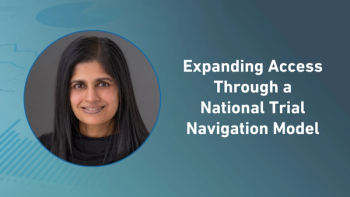Key takeaways
- Net treatment benefit (NTB) provides a more holistic, multidimensional assessment of treatment efficacy by integrating survival, quality of life, and safety outcomes.
- Generalized pairwise comparisons (GPC) used in NTB can reduce required sample sizes and improve trial efficiency by increasing statistical power.
- Incorporating NTB into trial design supports more patient-centered evaluations and may improve regulatory alignment and stakeholder engagement.
Traditional clinical trials tend to evaluate treatment efficacy through a single outcome, a univariate approach that lacks innovation and may not be the most efficient. Embracing multidimensional assessments presents an opportunity to capture a broader, more patient-centered perspective by factoring in diverse aspects of patients' experiences.
While treatment efficacy and regulatory approval often hinge on a single primary clinical endpoint, such as overall survival, other factors like quality of life (QoL) and toxicities are only separately considered. This fragmented approach fails to provide an integrated understanding of the overall treatment effects. To address this, two critical points emerge: we need more comprehensive benefit-risk assessments to capture the multifaceted impact of interventions, and we must elevate patient-centered outcomes such as QoL, giving them greater priority in evaluating treatment effects.
Recent advancements in statistical methodologies during the two last decades have introduced an approach that moves beyond isolated outcomes, focusing instead on a more holistic evaluation framework. This method enables comparisons between two trial arms across multiple prioritized outcomes, allowing researchers to estimate treatment effects and provide a complete, quantitative assessment of the overall net treatment benefit (NTB).
Learning from case studies: A shift in trial design
The limitations of traditional oncology trials become particularly evident when examining real-world examples of treatment evaluations.
The addition of oxaliplatin to 5-fluorouracil for metastatic colorectal cancer, for example, initially failed to gain FDA approval because its primary endpoint of overall survival (OS) missed statistical significance.1 However, the treatment exhibited significant benefits in progression-free survival (PFS). As such, oxaliplatin was later approved, and remains a standard of care today.
Conversely, the addition of erlotinib to gemcitabine for metastatic pancreatic cancer was approved based on a mild, yet statistically significant, progression-free survival (PFS) improvement.2 This evaluation, however, failed to capture the drug’s overall benefit-risk profile, as it did not consider toxicities or a quality of life decrease. The result has been limited adoption by the medical community, despite the regulatory approval.
These examples highlight the need for a broader, more inclusive assessment of treatment effect, a framework that captures both the risks and benefits of treatments in a robust way, whilst reflecting patient-centered priorities.
NTB is estimated using the statistical methodology, generalized pairwise comparisons (GPC). It is a powerful, flexible statistical tool that can provide a more holistic view of overall treatment benefit. It allows several outcomes to be analyzed simultaneously, within a single assessment. This approach generalizes the Wilcoxon Mann-Whitney test to accommodate all types of variables and multiple outcomes. In recent years, the pharmaceutical industry has increasingly adopted GPC, leading to regulatory approvals, particularly in the cardiovascular therapeutic area.
First, outcomes are ranked, from highest to lowest priority, based on the input from various stakeholders, e.g. pharma sponsors, key opinion leaders, clinicians, site investigators, patient advocates or even patients themselves. During analysis, every patient in the experimental group is compared to every patient in the control group across various outcomes, starting with the highest priority. Each pair of patients is categorized as “favorable” or “unfavorable” to experimental treatment, or “neutral.” In the case of “neutral” for the first prioritized outcome, the comparison is carried over to the next prioritized outcome.
The objective is to determine which patients benefited the most from treatment. Where the most important outcome is, for example, OS, it is easy to classify if one patient lived longer than the other. Yet if both were alive at the end of the trial, or lived a similar number of months, GPC allows researchers to evaluate secondary outcomes, such as tumor progression or severe adverse events, to determine which patient derived greater benefit from the treatment.
The NTB offers a clear and intuitive way to measure treatment effects. This methodology not only simplifies interpretation but also aligns closely with patient experiences. By prioritizing outcomes based on input from experts and patients alike, NTB reflects the most relevant metrics and results in a comprehensive assessment of treatment benefits.
It also makes trials more efficient. By simultaneously evaluating multiple outcomes, the approach increases statistical power, leading to a reduction in sample size required for a positive trial. By extension, studies recruit faster and cost less.
NTB in action: The SHAPERS trial
One example of a trial designed with the NTB in oncology is the short-course radiotherapy versus total neoadjuvant therapy in older rectal cancer patients (SHAPERS) trial. It focuses on treating rectal cancer in patients over 70—a group often overlooked in traditional studies.4 Instead of using a typical "non-inferiority" design, which requires large sample sizes and fails to consider the full spectrum of treatment effects that matter to patients,5 researchers have opted to use NTB. The clinical trial, which started enrolling in June 2024, is comparing multiple efficacy and safety outcomes (OS, PFS, disease progression, nerve damage, and grade ≥ 3 toxicities) all of which were chosen for their clinical significance and patient preference.4
Another compelling advantage of employing the NTB methodology is its ability to integrate toxicities as a key component of the evaluation process. This is particularly significant for the trial’s elderly patients who have experienced a relapse and are well-acquainted with treatment-related toxicities. For such individuals, the decision to undergo long and potentially taxing treatments again hinges heavily on the expectation of substantial survival improvements. The NTB balances the promise of extended survival against the realities of enduring treatment toxicities, delivering a more patient-centered assessment of therapeutic value.
A more efficient way to measure success
By listening to patient preferences, the NTB approach brings nuance to complex clinical trials, and ensures what matters to people living with cancer is taken into account. As oncology moves forward, this approach could become the hallmark of smarter, more efficient clinical trials that accelerate innovation—and provide people with faster access to treatments that truly meet their needs.
Rudradev Sengupta, Senior Trial Design Lead at One2Treat
References
- André, T., Boni, C., Mounedji-Boudiaf, L., et al. (2004). Oxaliplatin, fluorouracil, and leucovorin as adjuvant treatment for colon cancer. New England Journal of Medicine, 350(23), 2343-2351.
- Moore MJ, Goldstein D, et al. (2007) Erlotinib plus gemcitabine compared with gemcitabine alone in patients with advanced pancreatic cancer: a phase III trial of the National Cancer Institute of Canada Clinical Trials Group. J Clin Oncol 25: 1960–1966.
- Buyse, M. (2010). Generalized pairwise comparisons of prioritized outcomes in the two‐sample problem. Statistics in medicine, 29(30), 3245-3257.
- Saúde-Conde, R., Vandamme, T., et al. (2024). Efficacy and safety of short-course radiotherapy versus total neoadjuvant therapy in older rectal cancer patients: a randomised pragmatic trial (SHAPERS). ESMO Gastrointestinal Oncology, 4, 100067.
- Fleming, T. R. (2008). Current issues in non‐inferiority trials. Statistics in medicine, 27(3), 317-332.





